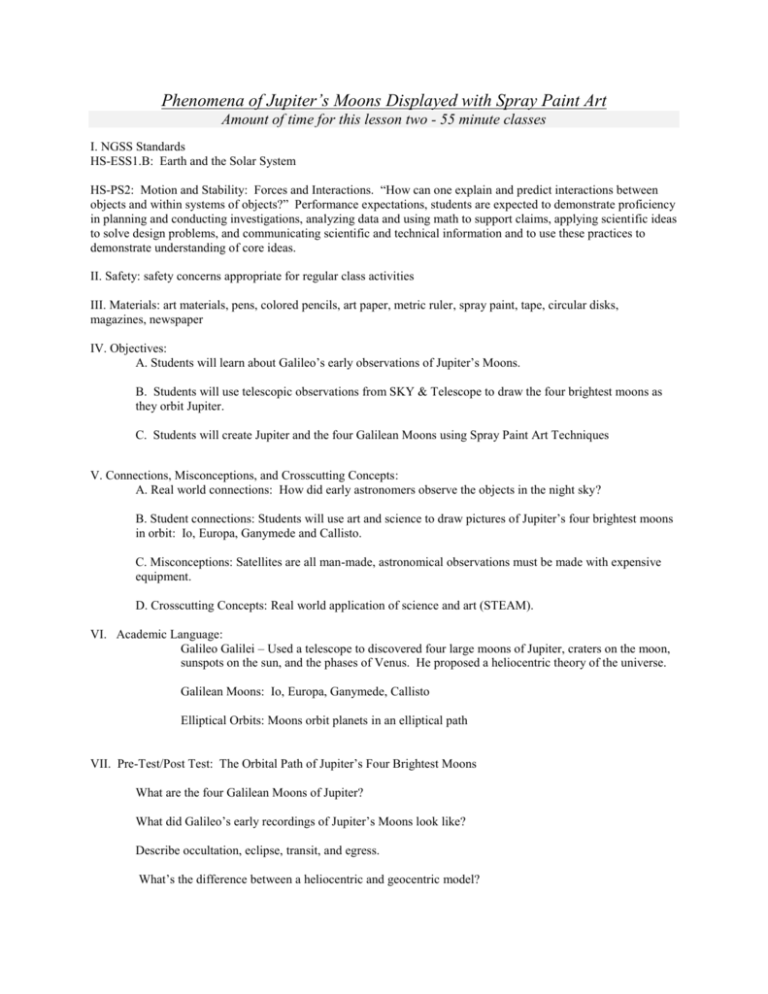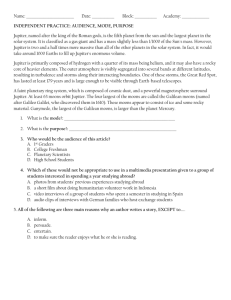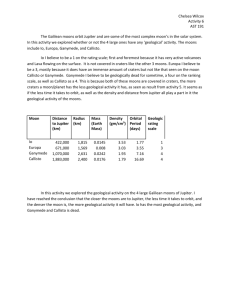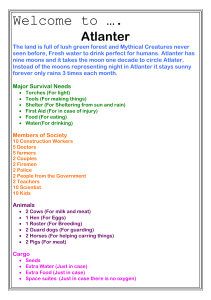Jupiter_Moons
advertisement

Phenomena of Jupiter’s Moons Displayed with Spray Paint Art Amount of time for this lesson two - 55 minute classes I. NGSS Standards HS-ESS1.B: Earth and the Solar System HS-PS2: Motion and Stability: Forces and Interactions. “How can one explain and predict interactions between objects and within systems of objects?” Performance expectations, students are expected to demonstrate proficiency in planning and conducting investigations, analyzing data and using math to support claims, applying scientific ideas to solve design problems, and communicating scientific and technical information and to use these practices to demonstrate understanding of core ideas. II. Safety: safety concerns appropriate for regular class activities III. Materials: art materials, pens, colored pencils, art paper, metric ruler, spray paint, tape, circular disks, magazines, newspaper IV. Objectives: A. Students will learn about Galileo’s early observations of Jupiter’s Moons. B. Students will use telescopic observations from SKY & Telescope to draw the four brightest moons as they orbit Jupiter. C. Students will create Jupiter and the four Galilean Moons using Spray Paint Art Techniques V. Connections, Misconceptions, and Crosscutting Concepts: A. Real world connections: How did early astronomers observe the objects in the night sky? B. Student connections: Students will use art and science to draw pictures of Jupiter’s four brightest moons in orbit: Io, Europa, Ganymede and Callisto. C. Misconceptions: Satellites are all man-made, astronomical observations must be made with expensive equipment. D. Crosscutting Concepts: Real world application of science and art (STEAM). VI. Academic Language: Galileo Galilei – Used a telescope to discovered four large moons of Jupiter, craters on the moon, sunspots on the sun, and the phases of Venus. He proposed a heliocentric theory of the universe. Galilean Moons: Io, Europa, Ganymede, Callisto Elliptical Orbits: Moons orbit planets in an elliptical path VII. Pre-Test/Post Test: The Orbital Path of Jupiter’s Four Brightest Moons What are the four Galilean Moons of Jupiter? What did Galileo’s early recordings of Jupiter’s Moons look like? Describe occultation, eclipse, transit, and egress. What’s the difference between a heliocentric and geocentric model? VIII. Catch/Engagement: Part A: Students will look at Galileo’s early drawings of Jupiter’s four brightest moons. http://www.splung.com/content/sid/7/page/earlymodels Part B: Show YouTube Video of Spray Paint Art of the Cosmos: https://www.youtube.com/watch?v=efxM_ojaYmM 7. Activity/Exploration: Students will look at Galileo’s early observations of the four brightest moons of Jupiter. Students will learn how to interpret the Phenomena of Jupiter’s Moons from January 2014 SKY & Telescope in order to construct artistic depictions of the moon’s orbital paths around Jupiter. Students will use Spray Paint Art to represent Jupiter and the orbits of the four brightest moons. 8. Review/Essential Questions/Explanation: A. Low Level – What are the four Galilean Moons and what planet do they orbit? B. Middle Level – What is the period of each moon? C. High Level – How can scientists use this information to predict how other satellites orbit planets? 9. Assessments (Post-test)/Evaluation: A. Formative: Check for understanding. Do students understand how to read the phenomena of Jupiter’s moons? B. Post-test--Identical to the pre-test plus: “What other questions do you still have about Jupiter’s moons?” C. Summative: Students will submit an artistic model of the orbit of Jupiter’s moons. 10. Timeline: A. Catch B. Pre-test C. Activity D. Review and Post-test 12 min 3 min 85 min 10 min 11. Enrichment/Elaboration: Discuss the planets in our solar system, their moons, Kuiper Belt and Asteroid Belt. 12. IEP Accommodations/Differentiation/Diversity: Instructor will provide accommodations as directed within individual IEPs. 13. Access data from the following website: http://www.skyandtelescope.com/wpcontent/uploads/WebJphenTab2014.pdf










